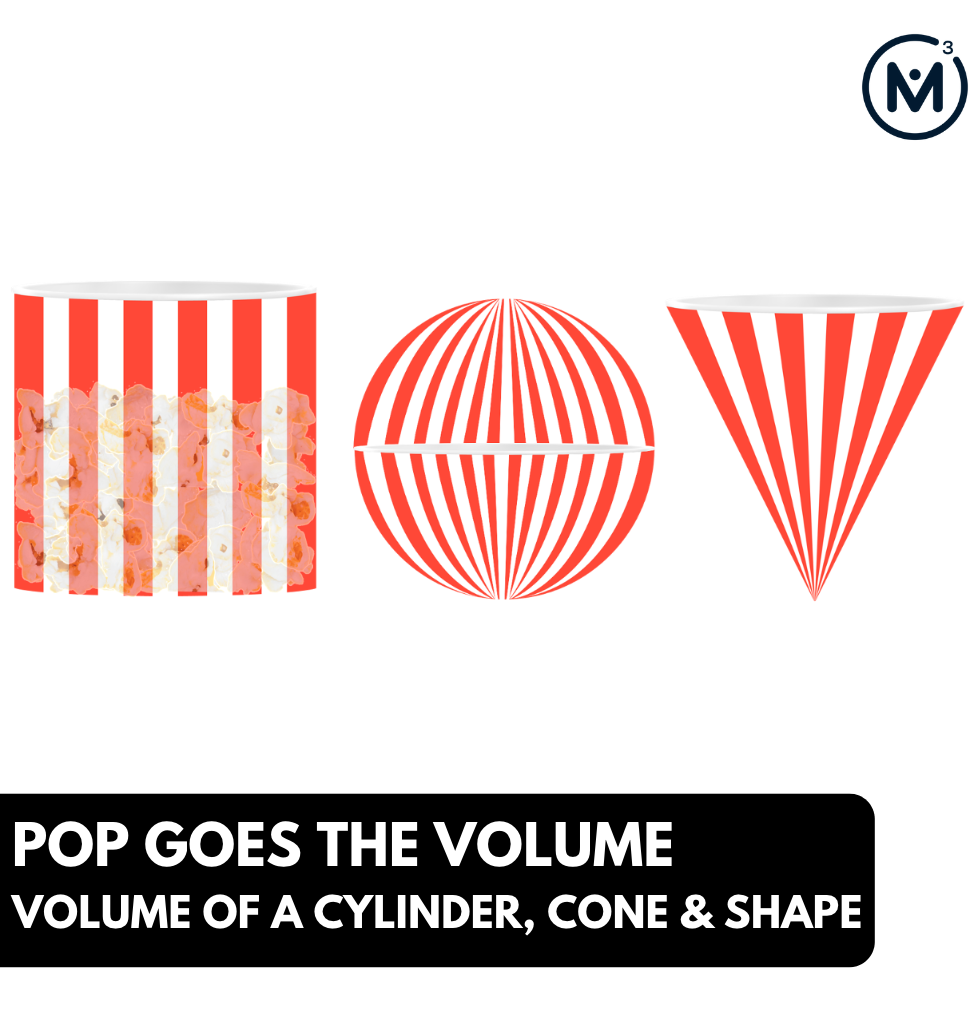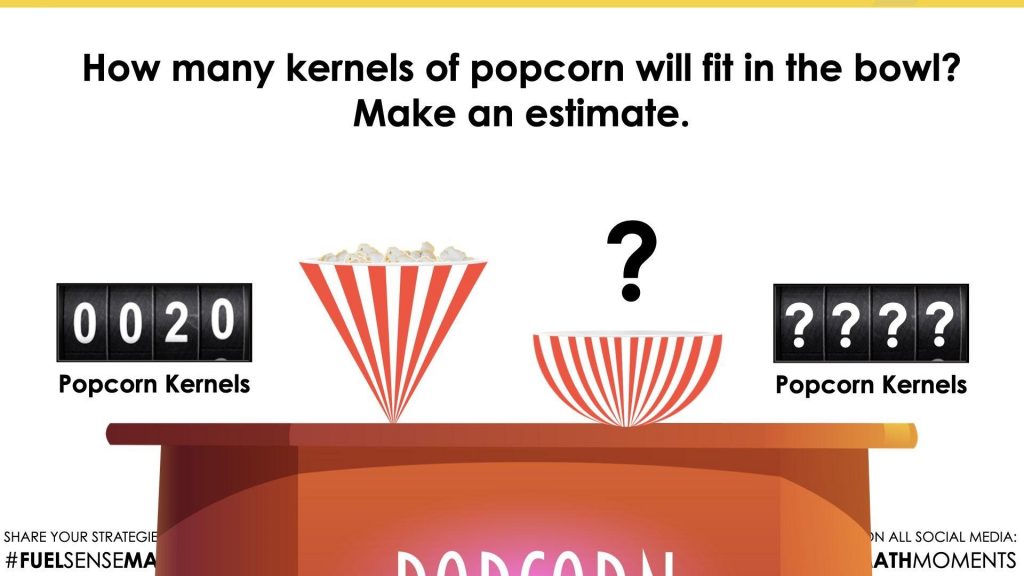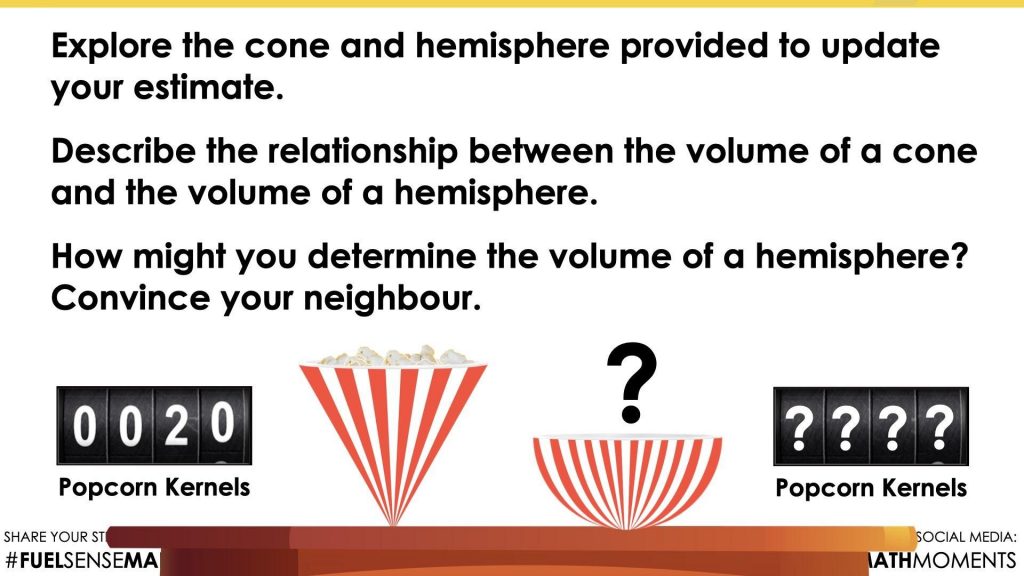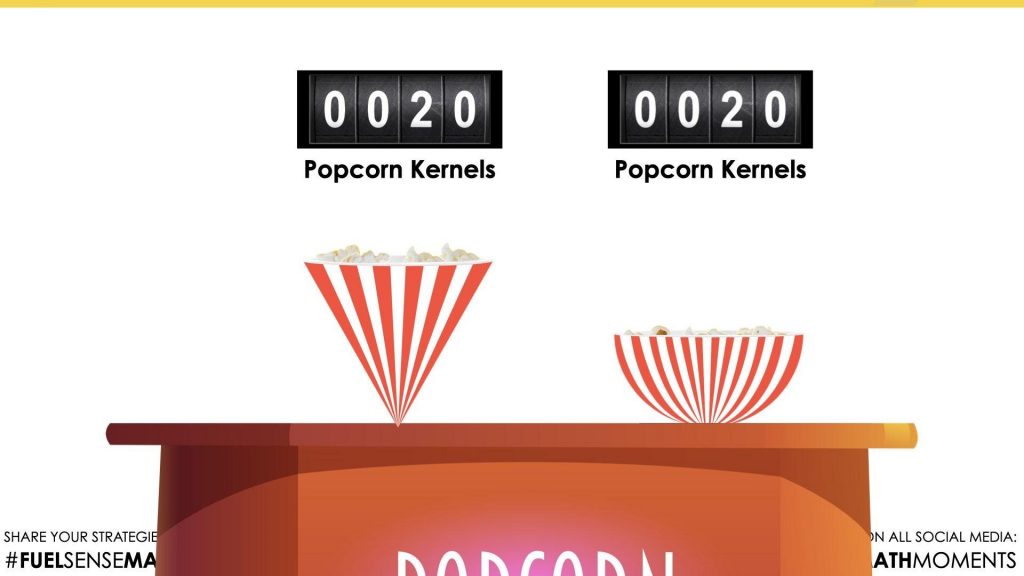POP GOES THE VOLUME [DAY 4]
VOLUME OF A CYLINDER, CONE & SHAPE
Investigate volume of a cylinder, cone and sphere by comparing different popcorn containers.
Intentionality
Spark Curiosity
Fuel Sensemaking
During Moves
Student Approaches
Next Moves
Consolidation
Reflect and Consolidation Prompts
Resources & Downloads
Educator Discussion Area
Intentionality & Unit Overview

Length of Unit: 6 Days
Access each lesson from this unit using the navigation links below
Students will estimate how much popcorn you can pour from a cone shaped container into a hemisphere shaped bowl to lead to the emergence that the volume of a sphere can be calculated by doubling the volume of a cone with the same radius and height.
Intentionality…
Students will explore the relationship between the volume of a cylinder, a cone and a sphere to emerge the formula for determining the volume of a sphere:
Volume of a Sphere, V=\(\frac{4πr^3}{3}\)
Some of the big ideas that will likely emerge in this lesson include:
- The volume of a 3-dimensional figure can be found by determining the number of cubic units that can be contained within the figure;
- The volume of a prism can be determined by finding the number of cubic units required to cover the base and multiply by the number of layers (i.e.: the height);
- The volume of a pyramid is one-third the volume of a prism with a congruent base and equivalent height. Therefore, the volume of a cone is also one-third the volume of a cylinder with a congruent base and equivalent height; and,
- The volume of a sphere is double the volume of a cone with an equivalent radius and equivalent height.
Spark Curiosity
What Do You Notice? What Do You Wonder?
Show students the following video of the cone shaped popcorn container and a hemisphere shaped bowl.
Then, ask students:
How many kernels of popcorn will fit in the bowl?
Make an estimate.
By asking students to make an estimate, they will be forced to leverage their spatial reasoning which provides a low floor opportunity for them to not only better understand the context, but to also begin nudging them to think about what will be important to make their estimate more precise as we continue through the lesson.
Ask students to share their estimates, but only their estimates without their thinking or reasoning yet. Invite all estimates into the conversation, and depending on the nature of what is shared and language used, could be an opportunity to discuss concepts further, such as understanding quantity relationships and change.
With the image projected, students can be asked what information might be helpful for them to work through the problem. This invites students into the conversation as co-constructors of their own learning. Allow for individual think time, students can then turn and talk to share their thinking in small groups, and finally a whole group discussion. Being strategic in how we respond will help lead students down the curiosity path towards conceptualizing the formula for the volume of a sphere. By inviting and recording (eg., post-it notes, whiteboard etc,.) all students’ thinking is validated and honoured.
Fuel Sense-making
Investigate
Provide students with a cone and a sphere that can be split into two equal sized hemispheres with the intent of updating their original estimate with a more precise estimate.
While you can also provide popcorn, using water, sand or rice will allow students to more clearly recognize the one to one volume relationship that exists between a cone and a hemisphere.
Note that the hemisphere must have the same radius as the base of the cone. The height of the cone and sphere (two identical hemispheres placed on top of one another to form a sphere) must be the same as double the radius OR equivalent to the diameter because a sphere’s height is the same as its diameter.
Prompt students to:
Explore the cone and hemisphere provided to update your estimate.
Describe the relationship between the volume of a cone and the volume of a hemisphere.
How might you determine the volume of a hemisphere? Convince your neighbour.
While working through this task, you might expect students to also draw on their previous learning as they begin to make sense of the relationship between all three figures explored (cylinder, cone and sphere) in this unit.
Facilitator Notes: Some students may be surprised that it takes 1 cone to fill up 1 hemisphere or 2 cones to fill up the sphere with popcorn. Other students may be ready to generalize that the volume of a sphere is \(\frac{2}{3}\) the volume of a cylinder. These, amongst other observations that will surface, can be used by the facilitator to help assess how far along their learning continuum students might be. For instance, are students struggling to see how filling up the sphere with popcorn using a cone relates to filling up a cylinder with popcorn using the same cone? Are students making a connection to previous learning on the relationship between a cylinder and a cone when calculating volume?
During Moves
While Students Are Investigating…
Login/Join to access the entire Teacher Guide, downloadable slide decks and printable handouts for this lesson and all problem based units.
Student Approaches
Student Approach #1: Manipulatives/Concrete Tools
Login/Join to access the entire Teacher Guide, downloadable slide decks and printable handouts for this lesson and all problem based units.
Student Approach #2: Applying the Formula for the Volume of a Cone
Login/Join to access the entire Teacher Guide, downloadable slide decks and printable handouts for this lesson and all problem based units.
Student Approach #3: Making Generalizations
Login/Join to access the entire Teacher Guide, downloadable slide decks and printable handouts for this lesson and all problem based units.
Next Moves
Consolidation
Consolidation: Volume of a Sphere Formula
Login/Join to access the entire Teacher Guide, downloadable slide decks and printable handouts for this lesson and all problem based units.
Reflect and Consolidation Prompts
Provide students an opportunity to reflect on their learning by offering these consolidation prompts to be completed independently.
Consolidation Prompt #1:
Login/Join to access the entire Teacher Guide, downloadable slide decks and printable handouts for this lesson and all problem based units.
Consolidation Prompt #2:
Login/Join to access the entire Teacher Guide, downloadable slide decks and printable handouts for this lesson and all problem based units.
Consolidation Prompt #3:
Login/Join to access the entire Teacher Guide, downloadable slide decks and printable handouts for this lesson and all problem based units.
We suggest collecting this reflection as an additional opportunity to engage in the formative assessment process to inform next steps for individual students as well as how the whole class will proceed.
Resources & Downloads
Login/Join to access the entire Teacher Guide, downloadable slide decks and printable handouts for this lesson and all problem based units.
Printable Lesson Plan PDF
Videos, Images & Media Files
Apple Keynote Presentation
Powerpoint Presentation
Printable Consolidation Prompts
Educator Discussion Area
Login/Join to access the entire Teacher Guide, downloadable slide decks and printable handouts for this lesson and all problem based units.
Explore Our 60+ Problem Based Units
This Make Math Moments Lesson was designed to spark curiosity for a multi-day unit of study with built in purposeful practice, number talks and extensions to elicit and emerge strategies and mathematical models.
Dig into our other units of study and view by concept continuum, grade or topic!





